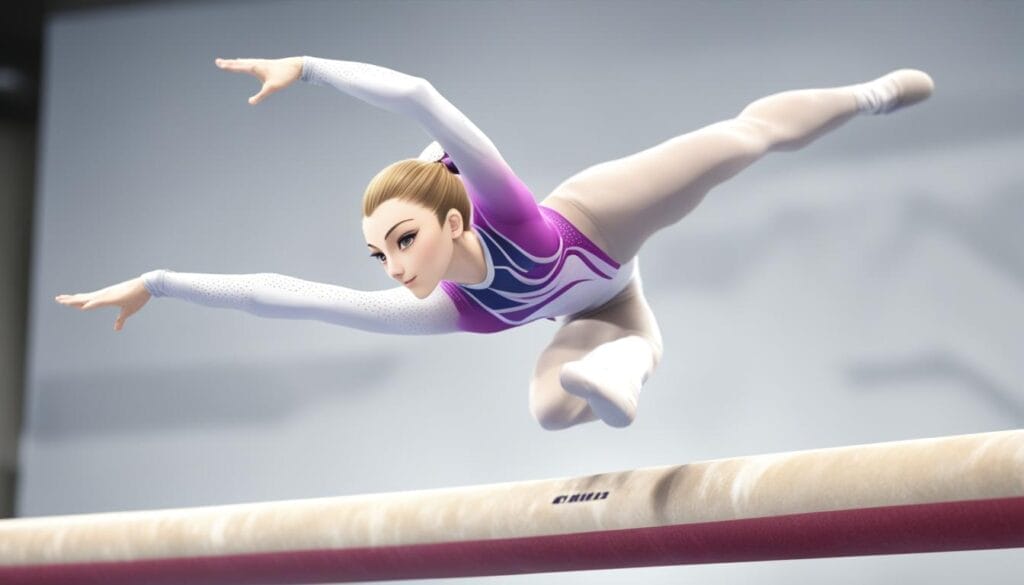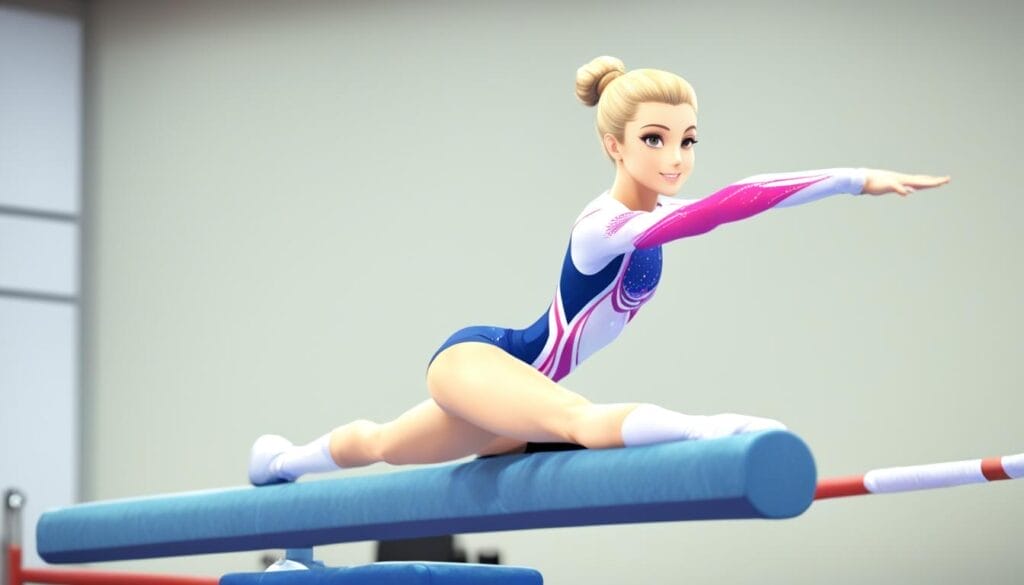Hi gymnasts! I’ve got an inspiring story to share with you. At first, I was amazed by those who could do the splits and other incredible moves. I thought they were just naturally gifted, leaving me dreaming of being like them.
Starting my gymnastics journey taught me otherwise. I found out that being flexible isn’t just in your genes. It’s a skill you work on with the right training. And believe me, it makes a huge difference!
Being flexible doesn’t just look good in moves; it also helps stay injury-free and perform at your best. From the splits to challenging backbends, the more your joints can move, the better your gymnastics will be.
So, ready to be a gymnastics star? I’ve got some great tips on flexibility for gymnasts!
Key Takeaways
- Flexibility for gymnasts is a crucial component of success in gymnastics.
- Improving flexibility needs focus and the correct training.
- Becoming more flexible not only improves your abilities but also lowers the injury chance.
- Being consistent with flexibility exercises is essential.
- Talking to a physical therapist helps avoid injuries and get expert advice.
The Benefits of Flexibility For Gymnasts
Flexibility is key in gymnastics, offering many advantages. It helps both beginners and experts in gymnastics perform better and lower the chance of getting hurt. This makes being flexible very important.
Being flexible means you can do movements with big ranges. This is essential for gymnasts as their acts need splits and high jumps. If you can’t do these well, your scores could become lower in competitions.
Moreover, being flexible might prevent injuries. It makes your joints and muscles more movable, saving you from hurts like strains. But too much stretching can also be bad, so it’s about finding the right balance.
Gymnasts can work on becoming flexible by adding stretches to their routine. These should target the muscles they need for their sport. They often use dynamic movements similar to what they do in their routines.
Static stretches are also helpful. These are where you hold a stretch without moving. Doing these after dynamic stretches can increase your flexibility even more.
Gymnastics Flexibility Drills
Most flexibility programs for gymnasts include drills like:
- Basic hamstring stretches
- Shoulder stretches
- Butterfly stretches for hip flexibility
- Backbends and bridges
- Splits training exercises
These drills can be arranged into a routine just for the gymnast. Using them regularly will slowly make you more flexible.
Flexibility improvement doesn’t happen overnight. It needs hard work and doing exercises regularly. Getting advice from a coach or therapist for a personalised plan is smart. With the right plan, gymnasts can be at their very best.
Dynamic Stretching for Flexibility in Gymnasts
Dynamic stretching is key for gymnasts to improve flexibility. It’s different from static stretching. Here, stretches are done in motion, just like their training and performances.
This method warms up the body and promotes blood flow. It’s ideal before gymnasts start their routines, making them ready for action.
Controlled motions at the limits of movement can boost muscle flexibility safely. This action also avoids overstretching, which is important.
Start dynamic stretching with easy, assisted movements. Gradually, reduce the help, moving to gravity’s resistance. This method teaches the body to handle more dynamic stretches over time.
Elite gymnasts might include some resistance in their stretching. This makes their routine harder but also boosts flexibility, perfect for mastering complex gymnastics moves.
Remember, younger gymnasts might not be ready for resistance training. They are still growing and should be careful with more demanding exercises.
For gymnasts wanting to get better, dynamic stretching is a must. These exercises help increase their movement range, flexibility, and lower injury risks.

Quick Dynamic Stretching Exercises:
- Controlled leg swings
- Arm circles
- Walking lunges with torso twist
- High knees with arm reach
- Hip circles
Adding these quick stretching routines can lead to better flexibility. It’s an important step for gymnasts before they take on the sport’s demands.
Static Stretching for Flexibility in Gymnasts
Static stretching helps gymnasts become more flexible. It’s different from dynamic stretching. In dynamic stretches, you move. But in static stretches, you hold a position. It’s a key part of a gymnast’s routine for better performance.
After dynamic stretches, add static ones to boost flexibility. Remember, warming up is crucial to preventing injuries. Static stretches help by warming up muscles and making them more flexible.
Gymnasts have many static exercises to choose from. These focus on areas like the shoulders and hips needed for their moves. Some examples are:
- Gravity-assisted floor angels: Lie on your back with arms out. Let gravity pull your arms down gently, feel the stretch, then hold for 20-30 seconds.
- Gravity-resisted floor angels: Start the same way but try to lift your arms up against gravity. Do this stretch for 20-30 seconds.
- Stick shoulder stretches: Grab a stick behind your back with palms facing forward. Lift it up to stretch your shoulders. Hold for 20-30 seconds.
Each stretch should be held 20-30 seconds and repeated in sets. But, don’t try to stretch too far to avoid getting hurt.
A gymnast’s stretch plan should include static and other techniques. Using dynamic stretches and foam rolling is great too. Together, these methods improve flexibility, performance, and safety.
References:
1. Johnson, A. (2019). The Role of Static Stretching in Gymnastic Training. Journal of Gymnastics Science, 36(1), 9-13.
2. Smith, B. (2020). Fundamentals of Flexibility: Static Stretching in Gymnastics. Gymnastics Today, 42(3), 27-31.
| Benefits of Static Stretching for Gymnasts | How to Perform Static Stretching |
|---|---|
| 1. Improves overall flexibility | 1. Warm up the muscles beforehand |
| 2. Enhances range of motion in key areas | 2. Hold each stretch for 20-30 seconds |
| 3. Reduces the risk of muscle imbalances | 3. Repeat multiple sets |
| 4. Helps prevent injury | 4. Do not push beyond your comfortable range of motion |
Other Techniques for Improving Flexibility in Gymnasts
Besides stretching, gymnasts can try self-massage with foam rollers to boost flexibility. Foam rolling helps relax muscles, aiding in better flexibility. It targets tight muscles, improving the ability to move freely.
Breathing exercises are key for gymnasts to get more flexible. Deep breaths help muscles relax, leading to better flexibility. Such exercises should be part of their routine to see big flexibility gains.
Flexibility training should mix different drills to target all body parts. This improves overall flexibility. Using various stretching techniques, like dynamic and PNF, helps gymnasts reach their flexibility goals.
Flexibility routines should match the gymnast’s skill level. Beginners start with basic exercises, moving to complex ones over time. Advanced gymnasts challenge themselves with harder exercises to push their flexibility even more.
Sample Flexibility Program for Gymnasts:
Let’s look at a flexibility program that can be adjusted for any gymnast:
- Start with dynamic warm-ups for the body
- Do dynamic stretches aimed at specific areas
- Follow with static stretches for more flexibility
- Use foam rollers for self-massage
- Include breathing exercises to help relax
- Practice PNF stretching for better motion
Regular practice is crucial for flexibility. Gymnasts should have set times in their week for it. This way, they will continuously improve their flexibility, bettering their gymnastics skills.
Combining foam rolling, breathing exercises, and various drills can really boost a gymnast’s flexibility. Being consistent and customizing the routine helps minimise injury risk and maximise their gymnastics performance.

Importance of Individualised Flexibility Training for Gymnasts
Flexibility training is very important for gymnasts. It must be tailored to meet each gymnast’s unique needs and goals. Every gymnast has different flexibility needs and skills. It’s crucial to check their flexibility often to see progress. This helps make the training programme better for them.
It’s essential to mix flexibility training with strength, technique, and ways to prevent injuries. By doing this, gymnasts can perform better and stay safe. By checking how they move, we can find and fix any problems. This makes a big difference in their training.
Benefits of Individualised Flexibility Training
Custom flexibility training helps gymnasts focus on what they really need. They design a special programme to get better at the moves they use most. This boosts their chances of doing well in competitions.
Having the right range of motion is key for precise moves and to avoid points taken off in competitions.
Monitoring and Adjustments
It’s key to regularly check how flexible gymnasts are. This way, coaches and gymnasts can change the training if needed. A flexible approach keeps each gymnast moving forward.
Flexibility training should never be a one-size-fits-all approach. Each gymnast has their own strengths and weaknesses when it comes to flexibility. By individualising their training, we can target their specific needs and help them achieve their full potential.
Combining Flexibility with Strength and Technique
Flexibility training works best with strength training and the right technique. Strength makes flexibility stronger. This mix helps gymnasts perform better and reduces injury risks.
Also, using the right technique means they use their flexibility well. This makes their moves not just flexible but also accurate.
Reducing the Risk of Injuries
A plan for custom flexibility can cut down on injuries. It targets weak spots to align and stabilize the body. This keeps away muscle and joint injuries during practice and shows.
Adding in injury prevention rules, like good warm-ups and cool-downs, also helps keep gymnasts healthy and flexible.
Creating a Comprehensive Program
A well thought out flexibility plan has lots of types of exercises. It might include different stretches, foam rolling, and breathing. This mix targets all parts of the body for better flexibility. A personal and full flexibility plan is the base for gymnasts to truly succeed.

Summing Up
Flexibility for gymnasts is key. It’s vital for success. I know how crucial it is to work on my flexibility daily. Two great ways to do this are through dynamic and static stretching. Doing these regularly helps gymnasts become more flexible and perform better.
There are more ways to boost flexibility. Using foam rollers for self-massage can ease muscle tension. Also, deep breaths during exercises are good for staying calm, which makes you more flexible.
It’s vital to tailor your flexibility exercises to your own body and aims. Seeing a physical therapist can help you do this right. They can also help you avoid getting hurt.
A full flexibility programme can really up your game and keep you safe. It needs commitment and regular practice. But, it truly pays off with better performance. No matter your skill level, focusing on flexibility is essential to reaching your best abilities.
FAQ
Why is flexibility important for gymnasts?
Flexibility is key for gymnasts. It lets them perform skills with full motion. This avoids point deductions in competitions. Flexibility also lowers the chance of getting hurt.
Which areas of the body require flexibility in gymnastics?
Hip and shoulder flexibility matter a lot in gymnastics. They’re needed for moves like splits, jumps, and leaps.
What is dynamic stretching?
Dynamic stretching is all about moving while you stretch. It warms up the body by copying gymnasts’ workout movements.
How does static stretching help improve flexibility in gymnasts?
Static stretching is about holding stretches still. It boosts flexibility more when done after dynamic stretching.
Are there other techniques for improving flexibility in gymnasts?
Many other techniques help. They include using foam rollers for self-massage and breathing exercises. Plus, there are special flexibility drills for every part of the body.
Why is individualized flexibility training important for gymnasts?
Custom flexibility plans are vital for gymnasts. They address each person’s unique needs and goals. This way, gymnasts perform better and are less likely to get injured.
Source Links
Share Me:
READY TO UNLEASH
YOUR BEST SELF?
Click “Sign Me Up!” And Start Your Fitness Transformation!





